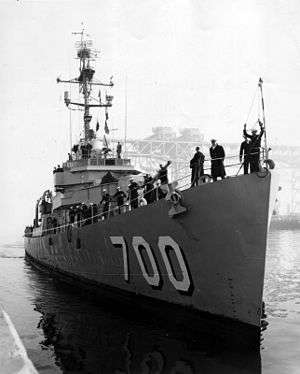USS Currier (DE-700)
 USS Currier (DE-700) in 1959 | |
| History | |
|---|---|
| Name: | USS Currier |
| Ordered: | 1942 |
| Builder: | Defoe Shipbuilding Co. |
| Laid down: | 1943 |
| Launched: | 14 October 1943 |
| Commissioned: | 1 February 1944 |
| Decommissioned: | 4 April 1960 |
| Fate: | Sunk as target off California on 11 July 1967 |
| General characteristics | |
| Class and type: | Buckley-class destroyer escort |
| Displacement: |
|
| Length: | 306 ft (93 m) |
| Beam: | 37 ft (11 m) |
| Draft: | 9.5 ft (2.9 m) |
| Propulsion: |
|
| Speed: | 23 knots (43 km/h) |
| Range: |
|
| Complement: | 15 officers, 210 men |
| Armament: |
|
USS Currier was a Buckley-class destroyer escort of the United States Navy, named after Lieutenant Roger Noon Currier. Currier was born in Portland, Oregon on 20 April 1913 and graduated from the United States Naval Academy on 3 June 1937. Embarked in USS Atlanta (CL-51), he was killed during the Naval Battle of Guadalcanal on the night of 13 November 1942.
Currier was launched on 14 October 1943 at the Defoe Shipbuilding Company, Bay City, Michigan. The ship was sponsored by Mrs. R. N. Currier, widow of Lieutenant Currier; and commissioned on 1 February 1944, with Commander Alfred L. Lind, USNR, in command.
After a voyage on convoy escort duty to Casablanca from 28 May to 17 June 1944, Currier returned to Oran on 10 July to escort convoys passing from Oran to Naples, Bizerte, Palermo, and Gibraltar. On 12 August, she cleared Salerno with a convoy of 112 LCI(L)'s and 28 other escorts carrying troops of the 45th Infantry Regiment, for the assault landings on southern France on 14 August 1944. Currier screened the transports during the landings, then guarded convoys from Oran to the beachheads from 20 August to 4 September. Between 10 and 20 September, she was escort commander of the "Naples Shuttle", providing supplies to the invading troops. After returning to Oran, she left on 28 September for the west coast of the United States, arriving at San Diego, California on 27 October.
Currier departed San Francisco on 23 November 1944 for Saipan, arriving on 28 December for radar picket duty, patrol, and to escort convoys to Eniwetok, Ulithi, Guam, and Iwo Jima. From 29 July 1945 until the end of the war, she voyaged between Guam and Okinawa on escort duty. On 28 August she joined USS Osmus (DE-701) to accept the surrender of the Japanese garrison on Rota, then inspected the island.
Currier departed Eniwetok on 19 September 1945 for overhaul at San Pedro. In March 1946, she was back in the Far East transporting Japanese prisoners of war from Hong Kong and Shanghai. After calling at Chinese ports, she patrolled along the Korean and northern China coast investigating small craft and taking the crew of six of these into custody for trial. She called at Manila, Philippines for a visit in February 1947, then returned to San Diego, arriving there on 2 March 1947. Between 1948 and 1952, Currier was on the west coast and in the Hawaiian Islands, concentrating on anti-submarine warfare training. On 19 April 1952, she sailed from San Diego for duty in the Western Pacific, patrolling off the east coast of Korea and in the Taiwan Straits, and participating in hunter-killer exercises in Japanese waters. Returning to San Diego on 6 September, she served as sonar school training ship until 20 May 1954 when she began her fourth Far Eastern cruise. Currier returned to San Diego on 7 September 1954 to resume local operations, primarily with the Fleet Sonar School, until being placed out of commission in reserve at San Francisco on 4 April 1960.
Currier received two battle stars for World War II service and one for Korean War service.
This article incorporates text from the public domain Dictionary of American Naval Fighting Ships.
External links
- Asa Wayne Arrington Papers (#849), East Carolina Manuscript Collection, J. Y. Joyner Library, East Carolina University, Greenville, North Carolina, USA. Materials concerning World War II veterans of the destroyer escort USS Currier (DE-700).